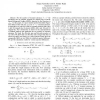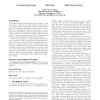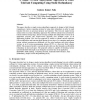143 search results - page 26 / 29 » Perfect Space Time Block Codes |
GLOBECOM
2006
IEEE
14 years 2 months ago
2006
IEEE
— For the number of transmit antennas N = 2a the maximum rate (in complex symbols per channel use) of all the Quasi-Orthogonal Designs (QODs) reported in the literature is a 2a�...
CORR
2010
Springer
13 years 7 months ago
2010
Springer
For a family/sequence of Space-Time Block Codes (STBCs) C1, C2, . . . , with increasing number of transmit antennas Ni, with rates Ri complex symbols per channel use, i = 1, 2, . ....
SIGIR
2002
ACM
13 years 7 months ago
2002
ACM
We present a novel sequential clustering algorithm which is motivated by the Information Bottleneck (IB) method. In contrast to the agglomerative IB algorithm, the new sequential ...
CODES
2003
IEEE
14 years 1 months ago
2003
IEEE
Multitasked real-time systems often employ caches to boost performance. However the unpredictable dynamic behavior of caches makes schedulability analysis of such systems difficul...
CLEIEJ
2006
13 years 8 months ago
2006
This paper describes a single-version algorithmic approach to design in fault tolerant computing in various computing systems by using static redundancy in order to mask transient...



